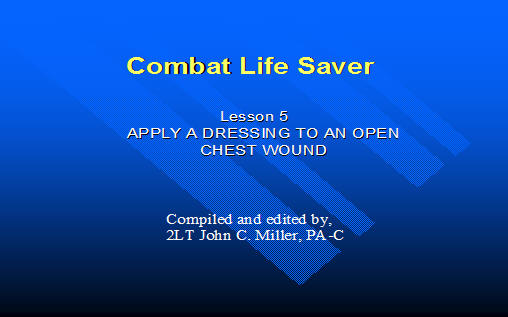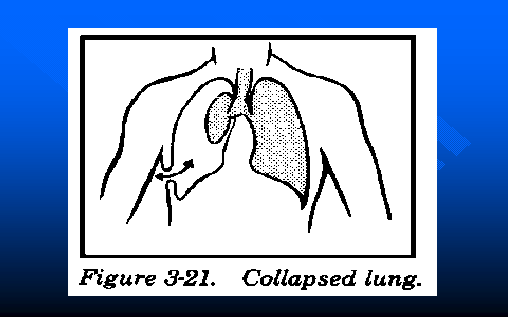APPLY A DRESSING TO AN OPEN CHEST WOUND
Click here to download the presentation.



Lesson 5
APPLY A DRESSING TO AN OPEN
CHEST WOUND
INTRODUCTION
If an object punctures the chest wall, permitting air to enter between the chest wall and the lung, the lung collapses. Any degree of collapse, interferes with the body’s ability to expand the lung and absorb oxygen. Even if one lung is collapsing, the other lung may be functioning, assuming that side of the chest is intact. The first aid procedure for a casualty with a penetrating chest wound is to prevent the lung from collapsing any more than it has already by placing an airtight seal over the wound.
APPLY A DRESSING TO AN OPEN
CHEST WOUND
TASK
Apply a dressing to a casualty with an open chest wound.
CONDITIONS
Given a simulated casualty with an open chest wound and needed supplies.
STANDARD
Score a GO on the performance checklist.
CHECK FOR SIGNS AND SYMPTOMS OF AN
OPEN CHEST WOUND
Obvious penetration of the chest wall by a bullet, knife blade, shrapnel, or other object.
Sucking sound coming from chest wound. (An open chest wound is often called a “sucking chest wound.”)
Frothy blood from chest wound. (Bubbles of blood are caused by air going in and out of the wound.)
Blood coughed up.
Shortness of breath or other difficulty in breathing.
Chest not rising normally when the casualty inhales.
Pain in the shoulder or chest area which increases with breathing.
CHECK FOR SIGNS AND SYMPTOMS OF AN
OPEN CHEST WOUND
Bluish tint to lips, inside of mouth, fingertips, or nailbeds. (The color change is caused by the decreased amount of oxygen in the blood.)
Rapid and weak heartbeat.
When in doubt, treat the wound as an open chest wound.
LOCATE AND EXPOSE OPEN CHEST WOUND
Check for entry and exit wounds.
Expose the area around the open chest wound by removing, cutting, or tearing the clothing covering the wound.
If clothing is stuck to the wound, cut or tear around the stuck clothing rather than removing the stuck clothing.
Do not try to clean the wound or remove impaled objects.
If you are in a chemical environment, seal and dress the wound without exposing the wound, other than the exposure needed to seal the wound.
LOCATE AND EXPOSE OPEN CHEST WOUND
Look for a pool of blood under the casualty’s back and use your hand to feel for wounds.
If there is more than one open chest wound, treat the more serious (largest, heaviest bleeding) wound first.
SEAL AND DRESS THE OPEN CHEST
WOUND
Since air can pass through a dressing, you must seal an open chest wound to stop air from entering the chest and collapsing the lung.
Open Field Dressing Wrapper
Tear open one end of the plastic wrapper of a field dressing.
Remove the inner packet.
Tear around the edges of the plastic wrapper until a flat surface is formed. Do not touch the inside surface of the plastic wrapper.
SEAL AND DRESS THE OPEN CHEST
WOUND
Seal the Wound
Tell the casualty to completely exhale and hold his breath. If possible, the casualty should hold his breath until the sealing material has been secured. Having the casualty to exhale forces some of the air out of the chest wound.
If the casualty is unconscious or cannot hold his breath, place the wrapper over the wound after his chest falls but before it rises.
SEAL AND DRESS THE OPEN CHEST
WOUND
Place the inside surface of the plastic wrapper (the side without printing) directly over the wound. The plastic wrapper makes an airtight seal which keeps air from entering the chest cavity through the wound. Breathing can be resumed.
If the edges of the wrapper do not extend at least two inches beyond the edges of the wound, it may not form an airtight seal and may even be sucked into the wound. If the wrapper is too small, use foil, a poncho, cellophane, or similar material as the seal.
If an object is protruding from the chest wound, place airtight material around the object and stabilize the object with clean, bulky material and bandage. Do not wrap the bandages around the object.
SEAL AND DRESS THE OPEN CHEST
WOUND
Tape the top and both sides of the plastic wrapper to the casualty’s chest. Leave the bottom edge untaped to form a flutter-type valve to allow air to escape through the chest wound, but keep air from entering the chest wound.
Apply the Field Dressing
Remove the field dressing from the paper wrapper.
Open the field dressing and place the white pad directly over the plastic wrapper.
SEAL AND DRESS THE OPEN CHEST
WOUND
Hold the dressing in place with one hand or have the casualty hold the dressing in place while you secure it.
Grasp one tail, slide it under the casualty, and bring it back over the dressing.
SEAL AND DRESS THE OPEN CHEST
WOUND
Wrap the other tail around the casualty in the opposite direction and bring it back over the dressing.
Tighten the tails and tie them with a nonslip knot over the center of the dressing when the casualty exhales. The bandages should keep the dressing and sealing material from slipping, but should not interfere with breathing.
SEAL AND DRESS THE OPEN CHEST
WOUND
If the casualty is unconscious, tie the knot after his chest falls.
If an object is protruding from the wound, tie the knot beside the object, not on it.
If the sealing material slips while the dressing is being applied or secured, repeat the procedures.
Seal and Dress Other Open Chest Wounds
If both an entry wound and an exit wound are present, both wounds must be sealed in order to stop the collapse of the lung.
SEAL AND DRESS THE OPEN CHEST
WOUND
Apply Manual Pressure
Apply direct manual pressure over the dressing for 5 to 10 minutes to help control bleeding.
The casualty can apply the pressure if he is able.
POSITION A CASUALTY WITH AN OPEN
CHEST WOUND
Position the casualty on his side with the injured side next to the ground. (If the casualty were to lie on his uninjured side, his uninjured lung would not expand as well.)
If the casualty can breathe easier when sitting up, allow him to sit with his back against a tree or other support.
MONITOR A CASUALTY WITH AN OPEN
CHEST WOUND
Treat the casualty for shock.
Evacuate the casualty as soon as possible.
If the casualty has increased difficulty in breathing, shortness of breath, or bluish tint to skin, quickly lift the sealing material from the wound, let the air escape with complete expiration, and reseal the wound
APPLY A DRESSING TO AN OPEN
CHEST WOUND
CLOSING
Once the casualty reaches a medical treatment facility, medical personnel can remove trapped air from the casualty’s chest and make the lung fully functional again.
Questions